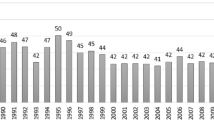Abstract
In academia, the term “inbreeding” refers to a situation wherein PhDs are employed in the very same institution that trained them during their doctoral studies. Academic inbreeding has a negative perception on the account that it damages both scientific effectiveness and productivity. In this article, the effect of inbreeding on scientific effectiveness is investigated through a case study. This problem is addressed by utilizing Hirsch index as a reliable metric of an academic’s scientific productivity. Utilizing the dataset, constructed with academic performance indicators of individuals from the Mechanical and Aeronautical Engineering Departments, of the Turkish Technical Universities, we demonstrate that academic inbreeding has a negative impact on apparent scientific effectiveness through a negative binomial model. This model appears to be the most suitable one for the dataset which is a type of count data. We report chi-square statistics and likelihood ratio test for the parameter alpha. According to the chi-square statistics the model is significant as a whole. The incidence rate ratio for the variable “inbreeding” is estimated to be 0.11 and this ratio tells that, holding all the other factors constant, for the inbred faculty, the h-index is about 89% lower when compared to the non-inbred faculty. Furthermore, there exists negative and statistically significant correlation with an individual’s productivity and the percentage of inbred faculty members at the very same department. Excessive practice of inbreeding adversely affects the overall productivity. Decision makers are urged to limit this practice to a minimum in order to foster a vibrant research environment. Furthermore, it is also found that scientific productivity of an individual decreases towards the end of his scientific career.









Similar content being viewed by others
Notes
Similar results are obtained when only mechanical engineering departments are considered.
Model is estimated also by using only rank specific, only department specific and non-specific (pooled data).
We would like to acknowledge the anonymous reviewer for pointing out this issue.
References
Baldock, C., Ma, R. M. S., & Orton, C. G. (2009). The h-index is the best measure of a scientist’s research productivity. Medical Physics, 36, 1043–1045. doi:10.1118/1.3089421.
Cameron, A. C., & Trivedi, P. K. (1998). Regression analysis of count data, Econometric Society Monographs No. 30. Cambridge: Cambridge University Press.
Glanzel, W. (2006). On the opportunities and limitations of the h-index [In Chinese]. Science Focus, 1, 10–11.
Greene, W. H. (2003). Econometric analysis. New Jersey: Prentice Hall.
Greenwood, M., & Yule, G. U. (1920). An inquiry into the nature of frequency distributions of multiple happenings, with particular reference to the occurrence of multiple attacks of disease or repeated accidents. Journal of the Royal Statistical Society, 83, 255–279.
Hamermesh, D. S., & Khan G. A. (2009). Markets for reputation: Evidence on quality and quantity in academe. National Bureau of Economic Research Working Paper Series, paper no: 15527.
Hirsch, J. E. (2005). An index to quantify an individual’s scientific research output. Proceedings of the National Academy of Sciences, 102, 16569–16572. doi:10.1073/pnas.0507655102.
Horta, H., Veloso, F. M., & Grediaga, R. (2010). Navel gazing: Academic inbreeding and scientific productivity. Management Science, 56, 414–429. doi:10.287/mnsc.1090.1109.
Jaffe, A. (1989). Real effects of academic research. American Economic Review, 79, 957–970.
Jin, B. H. (2006). h-index: An evaluation indicator proposed by scientist. Science Focus, 1, 8–9.
Jin, B. H., Liang, L., Rousseau, R., & Egghe, L. (2007). The r and ar indices: Complementing the h-index. Chinese Science Bulletin, 52, 855–863. doi:10.1007/s11434-007-0145-9.
Knetter, M. M., & Prusa, T. J. (2003). Macroeconomic factors and anti-dumping filings: Evidence from four countries. Journal of International Economics, 61, 1–17.
Lazaridis, T. (2009). Ranking university departments using the mean h index. Scientometrics, 82, 211–216. doi:10.1007/s1192-009-0048-4.
Long, S. L. (1997). Regression models for categorical and limited dependent variables. Thousand Oaks, CA: SAGE Publications.
Long, J. S., & Freese, J. (2003). Regression models for categorical dependent variables using stata. College Station, TX: STATA Press.
Nelson, R. R. (1993). National innovation system? A comparative analysis. New York: Oxford University Press.
Panaretos, J., & Malesios, C. (2009). Assessing scientific research performance and impact with single indices. Scientometrics, 81, 635–670. doi:10.1007/s11192-008-2174-9.
Rosenberg, N., & Nelson, R. R. (1994). American universities and technical advance in industry. Research Policy, 23, 323–348.
Author information
Authors and Affiliations
Corresponding author
Rights and permissions
About this article
Cite this article
Inanc, O., Tuncer, O. The effect of academic inbreeding on scientific effectiveness. Scientometrics 88, 885–898 (2011). https://doi.org/10.1007/s11192-011-0415-9
Received:
Published:
Issue Date:
DOI: https://doi.org/10.1007/s11192-011-0415-9




